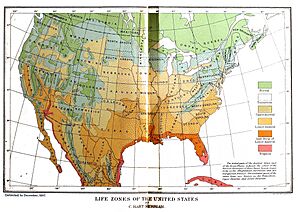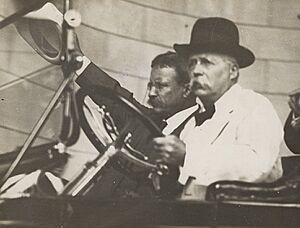Clinton Hart Merriam facts for kids
Quick facts for kids
Clinton Hart Merriam
|
|
|---|---|

Hart Merriam, c. 1901
|
|
| Born | December 5, 1855 |
| Died | March 19, 1942 (aged 86) |
| Nationality | American |
| Alma mater | Yale University; Columbia University |
| Known for | Life zone concept |
| Relatives | Florence Merriam Bailey (sister) Vernon Orlando Bailey (brother-in-law) |
| Scientific career | |
| Fields | Zoology Ornithology Mammalogy Ethnography Anthropology |
| Institutions | Academy of Sciences US Biological Survey United States Department of Agriculture National Geographic Society Biological Society of Washington American Ornithologists' Union US Board of Geographic Names American Society of Mammalogists Anthropological Society of Washington American Society of Naturalists |
| Author abbrev. (botany) | Merriam |
Clinton Hart Merriam (born December 5, 1855 – died March 19, 1942) was a famous American scientist. He studied many things, including animals, birds, insects, and how living things interact with their environment. He also studied human cultures and geography.
Merriam is often called the 'father of mammalogy'. Mammalogy is the scientific study of mammals, which are animals like bears, deer, and mice.
Contents
Early Life and First Expeditions
Clinton Hart Merriam was born in New York City in 1855. His father, Clinton Levi Merriam, was a U.S. congressman, which means he was a politician who helped make laws for the country. To avoid confusion with his father, young Merriam often used his first initial and middle name, becoming known as C. Hart Merriam.
Even though he was born in the city, Merriam grew up in a place called "Locust Grove" in Lewis County, New York. This home was close to the Adirondack Mountains, where he developed a strong interest in nature. His father encouraged him, giving him a rifle and a room to keep his animal specimens. Merriam learned how to prepare animal specimens (taxidermy) from a retired army doctor.
When he was 15, Merriam's father took him to meet Spencer Fullerton Baird at the Smithsonian Institution. Baird was a very important naturalist who was impressed by Merriam's collection. Baird helped Merriam start his scientific career. He arranged lessons for Merriam and recommended him for a special expedition.
The 1872 Hayden Expedition
Thanks to Professor Baird's recommendation, 16-year-old Merriam joined the Hayden Geological Survey in 1872. This survey was a scientific trip to explore and map parts of the American West. It helped lead to the creation of Yellowstone National Park.
Merriam's journey started in Utah and went through Idaho, Wyoming, and Montana, ending in the new Yellowstone National Park. He returned with many bird skins and nests. His report from this trip was his first big scientific publication about animals.
After the expedition, Professor Baird advised Merriam to go back to school to prepare for college.
Merriam's Education
Merriam followed Baird's advice and attended Pingry Military School and Williston Seminary. In 1874, he went to Yale University to study natural history and anatomy. While at Yale, he published papers about birds, including one that suggested bird distribution is affected by temperature.
He also became interested in medicine and surgery. This led him to move from Yale to the College of Physicians and Surgeons of Columbia University in 1877.
While studying medicine, Merriam helped start the Linnaean Society of New York, a group for naturalists. He also joined the Nuttall Ornithological Club. In 1879, he earned his medical degree (M.D.) from Columbia University and returned home to practice medicine.
From Doctor to Leading Scientist
From 1879 to 1885, Merriam worked as a country doctor in Locust Grove. He was good at it and even invented some medical tools. But his passion for wildlife never stopped. He kept in touch with other naturalists and continued to collect animal specimens, especially mammals.
In 1884, he published an important book called "Mammals of the Adirondacks." This book set a new standard for studying local wildlife, especially mammals, which was a new field of study at the time. He became very interested in why certain animals live in certain places.
Merriam also met Vernon Orlando Bailey, a talented animal collector. Bailey could find rare species, and Merriam hired him to collect specimens. Bailey later married Merriam's younger sister, Florence. By 1884, Merriam had collected over 7,000 mammal specimens! This was partly due to a new type of trap called the "cyclone" deadfall trap, which made it easier to collect small mammals.
In 1883, Merriam helped create the American Ornithologists' Union, a group for bird scientists. Even though he was young, he was chosen as a leader. His plans for studying bird migration and distribution were so big that they needed more money than the Union had. So, Merriam's father helped him get $10,000 from the U.S. government to start a new ornithology section within the United States Department of Agriculture. This new government job marked Merriam's shift from being a doctor to a full-time scientist.
Studying Animals and Life Zones
In 1886, Merriam became the first chief of the Division of Economic Ornithology and Mammalogy. This government office later became part of the United States Fish and Wildlife Service, which protects wildlife today. In 1888, he was also one of the people who helped start the National Geographic Society.
Merriam developed an important idea called "life zones." He noticed that as you go up a mountain, the types of plants and animals change, similar to how they change as you travel from the Equator to the North Pole. He classified different areas in North America based on their altitude and the types of life found there.
He was very detailed in his work, especially when classifying animals. For example, he identified many different species of North American brown bears.
In 1899, he helped a wealthy businessman named E. H. Harriman organize a scientific trip along the Alaska coastline.
Several animal species are named after Merriam to honor his work. These include Merriam's canyon lizard, Merriam's wild turkey, the now extinct Merriam's elk, Merriam's pocket mouse, Merriam's chipmunk, and Merriam's ground squirrel.
Focus on Native Americans
During his many trips to study animals in western North America, Merriam often relied on local Native Americans for information. He tried to learn their languages to communicate better. He became very interested in the Native American cultures of California.
Merriam realized that the languages, cultures, and knowledge of these tribes were disappearing quickly. He decided to collect as much information as he could before it was too late. His friends and colleagues were surprised when he decided to leave his work in mammalogy to study anthropology and languages, even though he hadn't formally trained in these fields.
After his friend Harriman passed away, Harriman's wife offered Merriam money to study whatever he wanted. With this support, Merriam focused on studying and helping Native American tribes in the western U.S. He collected a huge amount of information about their languages and customs. Much of his work remains unpublished, but it is stored at the Phoebe A. Hearst Museum of Anthropology at the University of California, Berkeley.
Personal Life
Merriam married Virginia Elizabeth Gosnell in 1886. She was his secretary. They were lifelong companions and often traveled together during his field work. They had two daughters, Dorothy and Zenaida.
His sister, Florence Augusta Merriam Bailey, was also a pioneering scientist who studied birds. She married Vernon Orlando Bailey, the animal collector who worked with C. Hart Merriam.
Merriam's grandson, Lee Merriam Talbot, also became a famous geographer and ecologist.
See also
 In Spanish: Clinton Hart Merriam para niños
In Spanish: Clinton Hart Merriam para niños
- Category:Taxa named by Clinton Hart Merriam
- C. Hart Merriam Base Camp Site
- Mount Merriam
- Merriam Peak (California)



